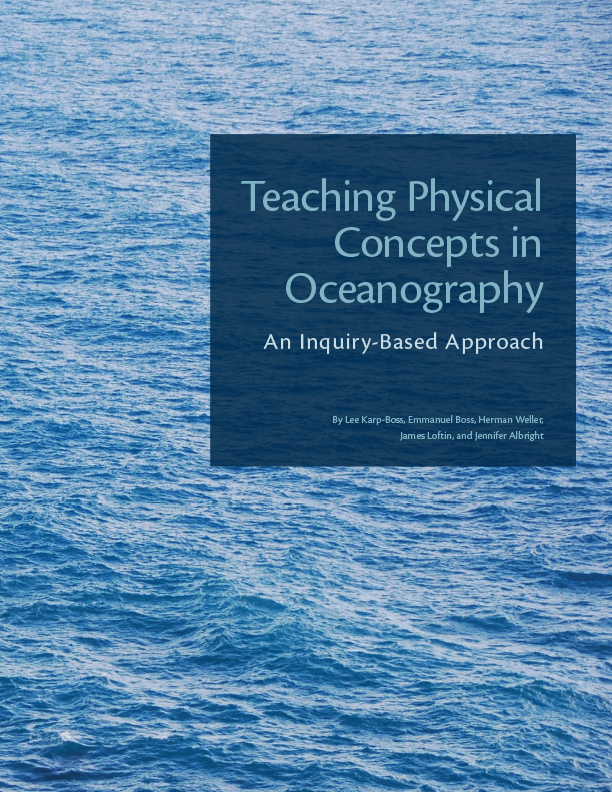Hands-On Oceanography
Hands-On Oceanography articles provide peer-reviewed activities appropriate for undergraduate and/or graduate classes in oceanography. Hands-on is broadly interpreted as those activities that actively engage students (i.e., activities where students have to make decisions, record results, and interpret results). Hands-on activities include, but are not limited to, computer-based models and laboratory demonstrations. Below is a list with links to all of the published activities.
We are no longer accepting submissions for DIY Oceanography articles. Instead, if you are interested in sharing your hands-on activity, we encourage you to review the criteria for Ocean Education articles on the Oceanography Author Guidelines page.
This supplement to Oceanography offers a collection of hands-on/minds-on activities for teaching physical concepts that are fundamental in oceanography. Versions in English, French, Spanish, Catalan, and Japanese are available for download.
A Low-Cost, DIY Ultrasonic Water Level Sensor for Education, Citizen Science, and Research
by P. Bresnahan, E. Briggs, B. Davis, A.R. Rodriguez, L. Edwards, C. Peach, N. Renner, H. Helling, and M. Merrifield
Do pH-Variable Habitats Provide Refuge for Stone Crabs from Coastal Acidification?
by P.M. Gravinese, S.M. Stewart, A.L. Smith, and J. Paradis
Sound and the Seafloor: Determining Bathymetry Using Student-Built Acoustic Sensors
by R. Levine, S. Seroy, and D. Grünbaum
Digging into the Geologic Record of Environmentally Driven Changes in Coral Reef Development
by P.M. Gravinese, R.B. Aronson, and L.T. Toth
Forces in an Estuary: Tides, Freshwater, and Friction
by D. Fugate and F. Jose
How Do Upwelling and El Niño Impact Coral Reef Growth? A Guided, Inquiry-Based Lesson
by P.M. Gravinese, L.T. Toth, C.J. Randall, and R.B. Aronson
Assessing Cross-Shore and Alongshore Variation in Beach Morphology
by S.L. Gallop, M.D. Harley, R.W. Brander, J.A. Simmons, K.D. Splinter, and I.L. Turner
Observing the Ocean with Gliders: Techniques for Data Visualization and Analysis
by C.E. Hanson, L.M. Woo, P.G. Thomson, and C.B. Pattiaratchi
Paleoclimate Reconstruction from Oxygen Isotopes in a Coral Skeleton from East Africa: A Data-Enhanced Learning Experience
by D.P. Gillikin, A. Verheyden, and D.H. Goodwin
Building Intuition for In-Water Optics and Ocean Color Remote Sensing: Spectrophotometer Activity with littleBits™
by S. Schollaert Uz
Mimicking the Rayleigh Isotope Effect in the Ocean
by E.M. Griffith, J.D. Ortiz, and A.J. Jefferson
Turbidity Currents: Comparing Theory and Observation in the Lab
by J.D. Ortiz and A.A. Klompmaker
Ocean Acidification: The Role of CO2
by J.L. Murphy and C.I. Measures (also available in Chinese)
Corals on Acid: An Inquiry-based Activity Leading Students to a Better Understanding of Ocean Acidification Impacts
by C.L. Boleman, P.M. Gravinese, E.N. Muse, A.E. Marston, and J.G. Windsor
Engineering Literacy for Undergraduates in Marine Science: A Case for Hands On
by E. Boss and J. Loftin
Lake in a Bottle: A Laboratory Demonstration of the Unusual Stability Properties of Freshwater
by J.A. Austin, E.B. Voytek, J. Halbur, and M.A. Macuiane
Drifters, Drogues, and Circulation
by T.O. Manley
Sorting Out Sediment Grain Size and Plastic Pollution
by H.L. Spalding, K.M. Duncan, and Z. Norcross-Nu’u
A Classroom Activity Using Satellite Sea Surface Temperatures to Predict Coral Bleaching
by B.A. Parker, T.R.L. Christensen, S.F. Heron, J.A. Morgan, and C.M. Eakin
Mix it Up, Mix it Down: Intriguing Implications of Ocean Layering
by P.J.S. Franks and S.E.R. Franks
A Tabletop Demonstration of Atmospheric Dynamics: Baroclinic Instability
by B.T. Nadiga and J.M. Aurnou. 2008
Assessing the Importance of Sand as a Source of Fecal Indicator Bacteria (Escherichia coli and Enterococcus)
by K.L. Knee, R.L. Leopold, E.R. Madsen, and A. Paytan
A Laboratory Demonstration of Coriolis Effects on Wind-Driven Ocean Currents
by D. Beesley, J. Olejarz, A. Tandon, and J. Marshall
Diffusion at Work—An Interactive Simulation
by L. Karp-Boss, E. Boss, and J. Loftin
Phosphorus in Our Waters
by A. Paytan and K. McLaughlin
Investigating Coastal Processes and Nitrate Levels in the Elkhorn Slough Using Real-Time Data
by L.G. Adams and G.I. Matsumoto
An Integrated Model Simulation and Empirical Laboratory on Biological Encounter Rates
by S. Menden-Deuer
An Introduction to Finding Context
by J. Boucher and L.E. Sahl
Settling Particles in Aquatic Environments: Low Reynolds Numbers
by E. Boss, L. Karp-Boss, and P.A. Jumars
In addition to the recurring column, the supplemental issue of Oceanography, Teaching Physical Concepts in Oceanography, offers a collection of hands-on/minds-on activities for teaching physical concepts that are fundamental in oceanography.
Background photo credit: Amanda Cotton/Ocean Image Bank

© 2025 The Oceanography Society
1 Research Court, Suite 450-117, Rockville, MD, 20850, USA | Phone: (1) 301-251-7708 | [email protected] | Privacy Policy





